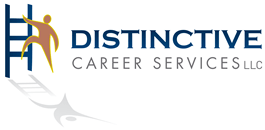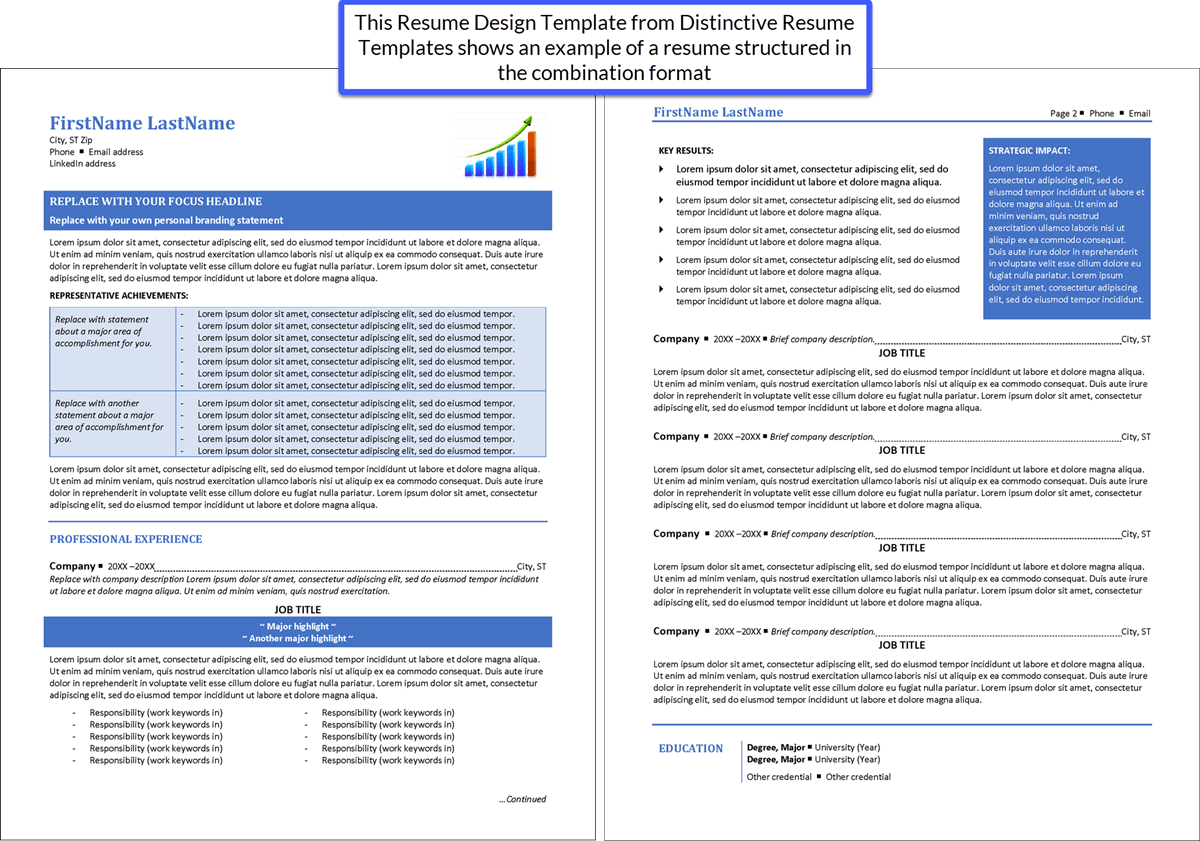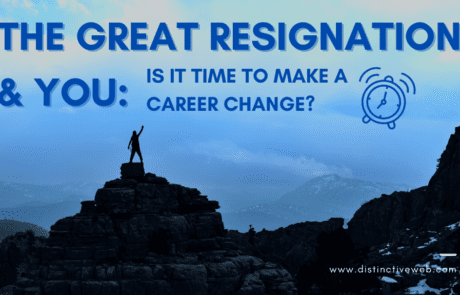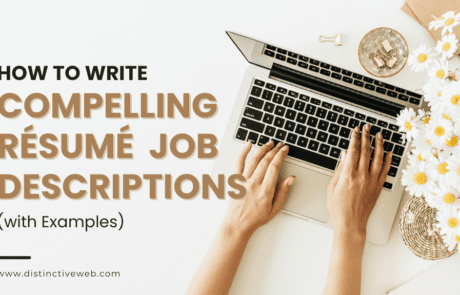
How to write a resume–not to mention a GREAT resume–is a question that challenges almost every job seeker at the start of every new job search.
It’s no secret that learning how to write a resume is an essential skill for career success, and actually writing a great resume is one of the major keys to scoring your dream job. Your resume is one of the most important documents you’ll ever create.
A good resume can help you win the attention of hiring managers and land interviews, while a poor one may never even be read.
So, how do you write a compelling, results-generating resume?
If you are like most job seekers, you scour Linkedin and maybe a few job boards and find job openings you think are a good fit for your qualifications. You don’t really spend too much time learning how to write a resume. After all, how hard can it be?
You sit down and get to work writing a resume in the style you learned from the career center when you graduated from college a decade ago, and then submit it for the job openings you’ve identified.
A week goes by with no response. You look for new job ads, ensuring they haven’t been out there too long. (You forgot to check that before.) Send more resumes and wait. This time you send them with a cover letter, which you’ve heard may be necessary.
Another week, but this time you DO get a response. A form letter that says the equivalent of “Thanks for applying, but we’re moving on with more qualified candidates.” This is a shock because, looking at the job description, you ARE the qualified candidate.
Time to up your game. You reach out to people in your professional network to ask for their referrals. Then you get to work again fixing your resume–writing a new and improved one (or so you hope!). And once again, you send your latest resume—this time in a more personal way, to contacts recommended by people in your network. You also do a better job of personalizing and tailoring each cover letter.
Crickets.
There’s something wrong here. It’s time to realize that something isn’t working.
Finally, it is time to face the obvious. It’s not you. It’s probably not your job search strategy either. Most likely, it’s your resume.
That’s the common denominator.
Your resume needs an overhaul, and this time around, you need a better approach.
Here then, is a step-by-step formula and pro resume tips for how to write a resume that will get you the results you want and help you land your dream job.
Let’s get started.
Step 1. Define the focus of your resume
A targeted resume will always be more effective than a general resume. You must clearly define your resume focus before you can even begin to think about sitting down to make a resume. It is the foundation for your entire resume.
Your focus is your target for your job search. The more clearly you can describe it, the better. What type of job and level of position do you hope to land? Are you focusing on specific industries? Do you want to work for small companies or large companies? Make your resume focus crystal clear.
Your resume should begin with a professional summary, and that summary should start with a headline statement that immediately conveys your focus.
A focus headline statement is subtly different from a resume objective statement. Make sure you understand the difference. Most resume and career experts advise against including a resume objective in a modern resume.
Your headline will often begin with the type and level of job you want (try to use the exact job title) as well as the industry focus if relevant. In some cases, you may also want to include a subheadline.
This allows you to be more precise by calling out other factors such as the size of the company (e.g., small business vs. Fortune 500 vs. multinational) or the type of challenge they may be facing (e.g., start-up company vs. growing company vs. turnaround).
Here is an example of what a resume focus headline and subheadline might look like:
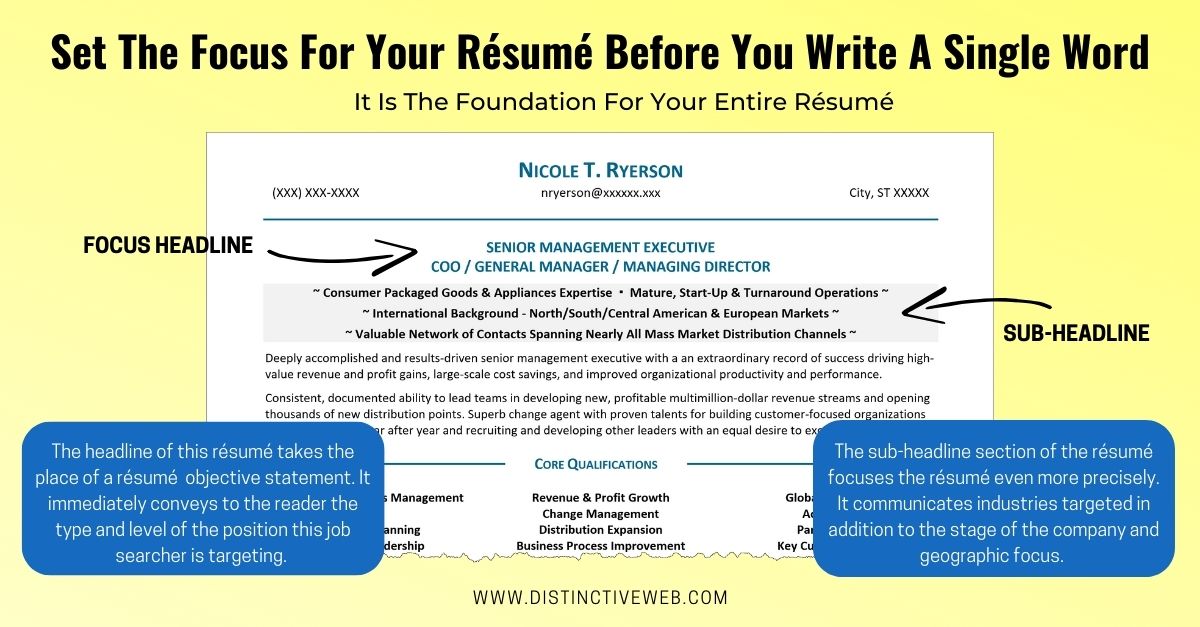
The focus of your resume serves as the foundation for all the resume sections, beginning with the resume summary statement right through your work history, resume job descriptions, and education section.
Step 2. Figure out your keywords
When resume writing, it’s all about keywords. Nearly all recruiters and many companies use an applicant tracking system (ATS) to manage applicants throughout the hiring process. So when you send your resume in response to a job ad or apply for a job in any other way, it is a near certainty that the recipient will enter it into an ATS.
But won’t it get lost in the ATS? This is where keywords come into play. Including the right keywords in your resume is how your resume will be recalled from these applicant tracking systems to be reviewed by a real person. Potential employers search the ATS using keywords to describe the qualifications they seek in the perfect job applicants.
The “trick” is to know the keywords your future employer will use in this search. While this isn’t an exact science, you can get some good clues by carefully reading the job posting. Most of the time, keywords are nouns or noun phrases describing the job duties and responsibilities described in the job ad, and they may be either hard skills or soft skills.
But don’t start to write your resume just yet. For now, gather 6 to 12 job postings that fit your focus. Read through each job ad and make a list of the key terms and phrases that describe the qualifications each employer is seeking. Add any others that you think are important in your profession or industry. Think about hard and soft skills, technical skills, transferable skills, and other specific requirements for the type of job you are targeting.
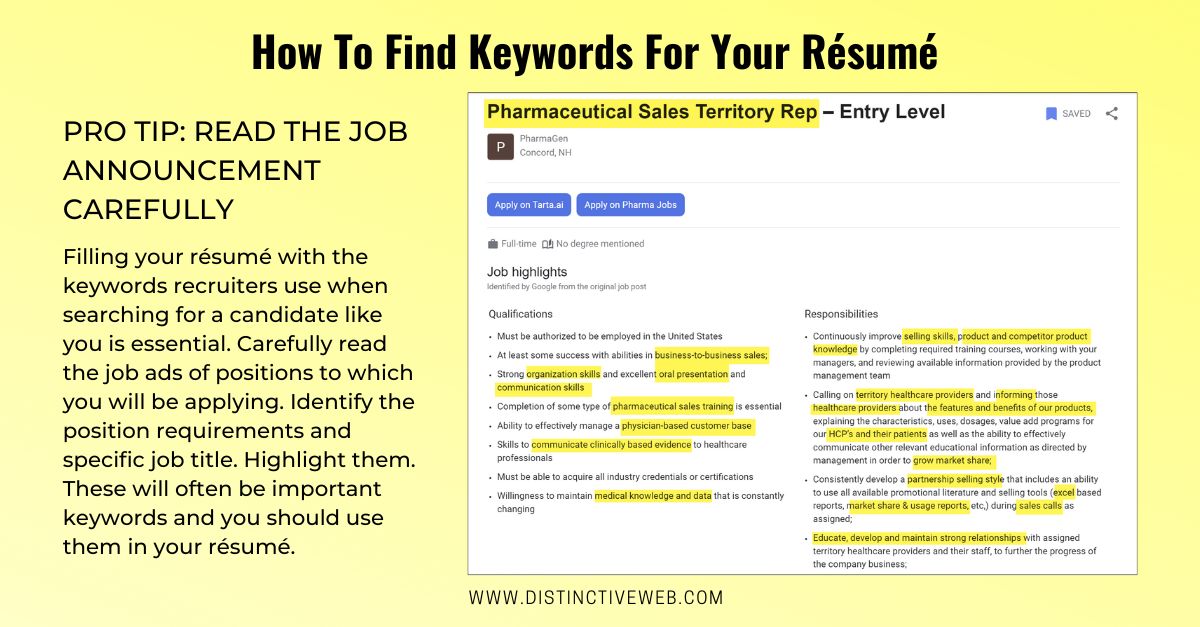
Be thorough. You will use these terms when writing your resume, including them in not just a skills section but also interspersing them with wording to emphasize skills throughout your employment history section and other resume sections. So, keep this list of keywords handy.
Step 3. Think like a hiring manager
One of the best resume-writing tips you will ever hear is to imagine that you’re the hiring manager looking for someone to fill the type of job you are targeting.
What do you, as the hiring manager, want in the applicant for the job? What’s the most pressing problem you’re trying to solve? What goal do you hope your new hire will help you achieve? Write down whatever comes to mind.
Look again through the 6-12 job postings you identified in the last step. Next, visit the websites of each company and read through any recent news or press releases you can find.
After learning as much as you can about each company, brainstorm again and add to your list of hiring managers’ needs.
Are they worried about competition? Do they need to make money? Save money? Improve quality? Grow their customers? Keep their customers? Satisfy regulators?
Once you have a good description of what employers need, examine your work history and how your accomplishments from previous jobs would satisfy those needs. Document these stories. In other words, write the narrative for each story of career success.
To do so, describe…
- the challenge or problem you faced,
- what you did,
- what the result was and
- what the big-picture impact was.
This is called the CAR approach to resume writing (challenge, actions, results) or the CARS approach (challenge, actions, results, strategic impact).
The following image shows how you can use these CAR narratives when writing your resume
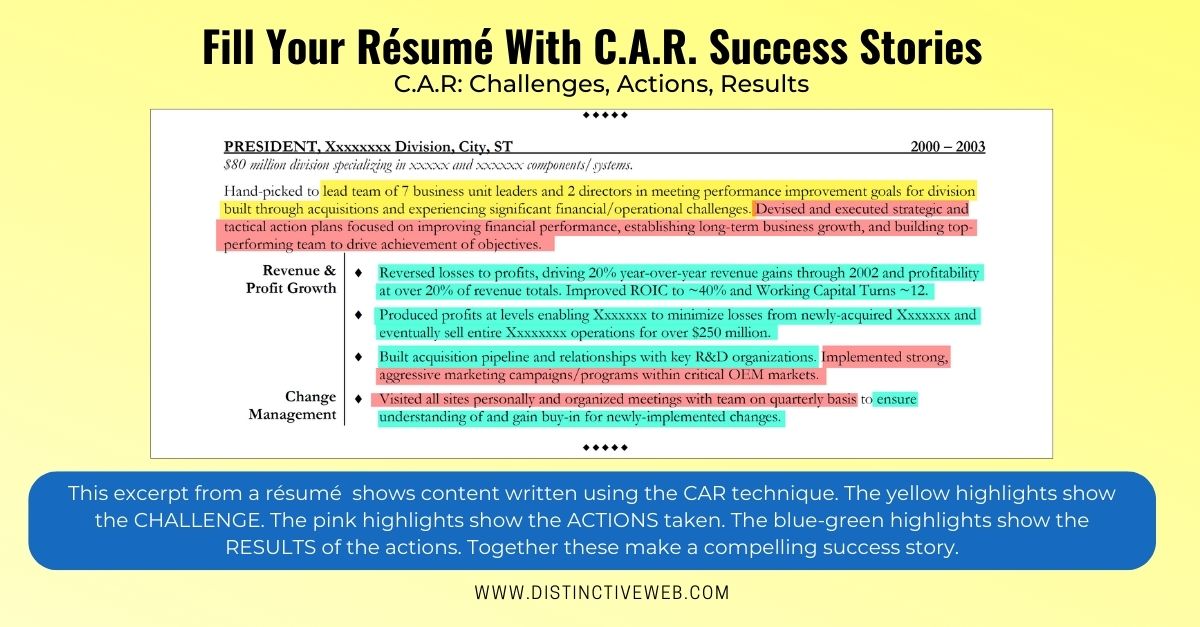
While you’re at it, visualize what the other applicants for the job might bring to the table regarding work history, educational credentials, and accomplishments.
How do you stand out from your competition? What differentiates you? Figure out the added value that you bring and create narratives around that.

This process helps develop the content you need when writing a resume and lets you pre-think what you’ll discuss during interviews.
Step 4. Time to make a resume: Easy stuff first
To get past the “fear of the blank page” when you sit down to write a resume, start with just the basics of your job history experience and education.
Create a resume header at the top of the page with your name and contact information. This should include your city, state, and zip; a phone number; and a professional email address. If you have a LinkedIn profile (if you don’t, you should create one now), include a link to that as well.
Begin the content of your professional resume with your resume objective expressed as a focus headline.
Now, to show your career progression, make a list of where you worked, your job title, and the relevant dates.
Next, list your schools, degrees, and the year you graduated. You can also list professional credentials, certifications, awards, affiliations, and industry-specific training.
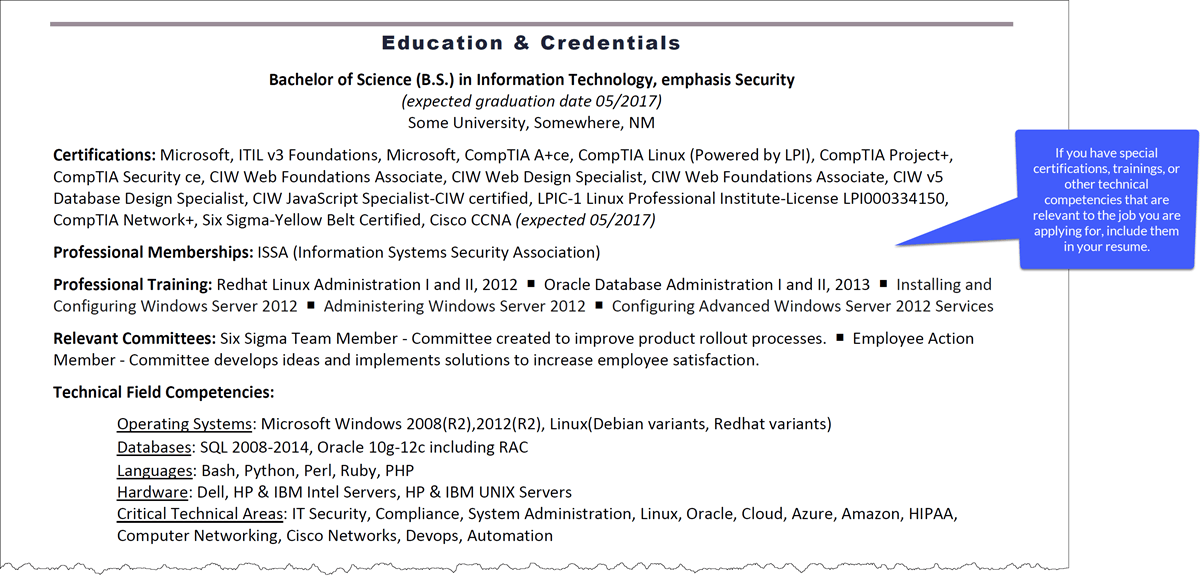
This is also the time to start thinking about your resume format. The right resume format for you will depend on the specifics of your professional experience and current career goals.
A functional resume may be best if you are making a career change. But most job seekers will find that a combination resume format will be best.
Many job seekers would consider this type of formatting a traditional resume style. However, combination resumes blend the best of both a functional resume format with a chronological resume format.
This is an example of a combination resume:
Writing your resume in this style will begin with a professional summary, followed by your work history in reverse chronological order, and end with an education section.
If you are a young professional or graduating student without much employment experience, include volunteer experience or other experience that shows how you are qualified for the job.
Reviewing the resume examples in our portfolio will give you some inspiration for your own resume formatting.
Step 5. Now the good stuff
Once again, review your keyword/keyphrase list from Step 2 and your narrative successes from Step 3.
Then start writing the body of your resume. Don’t edit or worry about format or sentence structure at this stage. Just write. You can edit and refine your resume later.
Write a job description using your success narrative and keywords for each specific job you’ve held. Incorporate soft skills into your success stories, but don’t just list them. Instead, use examples to show how you use these soft skills to benefit past employers.
Remember that a good resume should be easy to read. Consider using bullet points for your accomplishments.
While bullet points are an excellent formatting technique, be selective in how you use them. They should be used to make key points stand out. If you bullet point everything, they all blend together, and nothing stands out.
A balance of short paragraphs and bullet points works best when resume writing.
Forget listing your responsibilities for each employment experience – they tend to get repeated from job to job and look like filler.
Besides, remember that job “responsibilities” are just a statement of what you were supposed to do–not what you actually did. Therefore, it is much better to emphasize accomplishments than job responsibilities.
Yet, as we’ve already explained, these responsibilities are often the words that are used in a job ad to describe the qualifications sought, so they can be essential keywords.
One solution is to create a skills section as part of your professional summary. This gives you a place to list skills that you know will be important keywords. Go back to your list and see if there are technical skills or other hard skills that you can list in a skills section.
You have many different options to include relevant skills in a skills summary. Here is just one example.
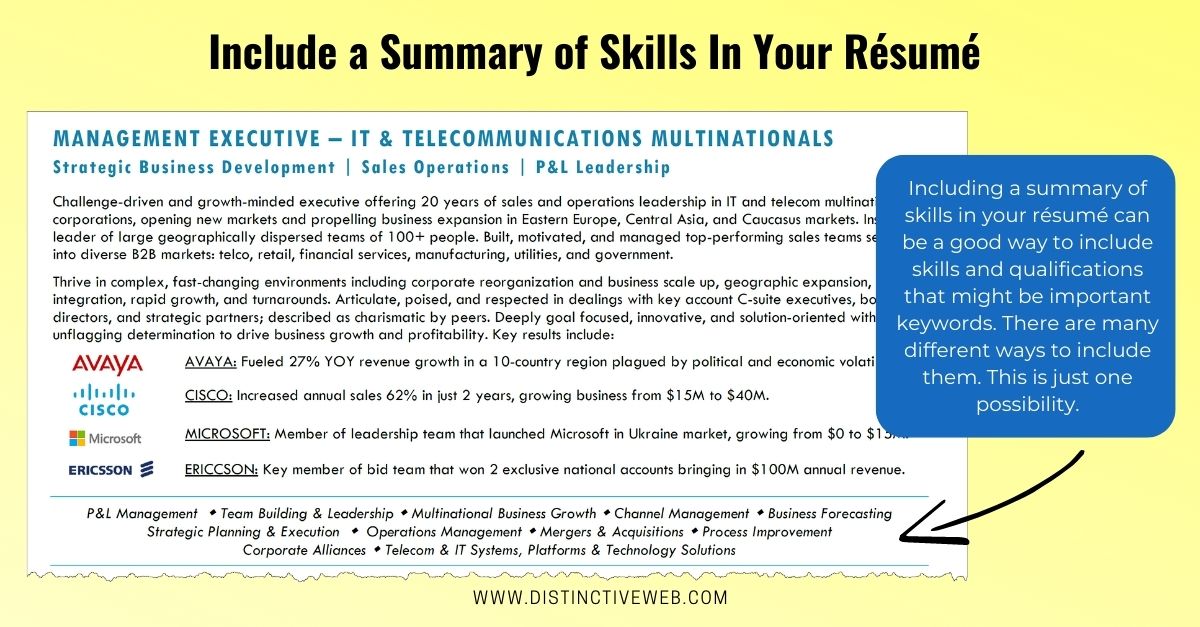
Step 6. Clean it up
This is the stage of resume writing during which you will begin editing. If you did the brainstorming to flesh out all you’ve done as recommended, you’ll almost certainly have listed accomplishments that aren’t really relevant for your focus and target reader.
Go back and edit your wordy prose and delete irrelevant information. You must keep your resume relevant to your intended reader or you will lose them. Reread the job ad and ensure you’ve addressed all the major requirements. Keep in mind that this might mean you will need to create a customized version of your resume for each application.
In some cases, you might need to cut content for the sake of space on the page. Ideally, you won’t want your resume to run over two pages. One page is best for young professionals with little experience. Three pages are acceptable if you are an executive or work in a technical profession.
If you do find yourself cutting information that may be relevant, there may be an opportunity to repurpose that content in your cover letters or maybe in your LinkedIn profile.
The only cardinal rule when you make a resume is to be honest. (IMPORTANT: If you’ve ever considered putting something dishonest on a resume, like a degree you don’t have, DON’T. You WILL be found out, and the consequences will NOT be good.)
Try to create clean, compelling, well-written statements. Review the content for consistent sentence structure, properly used bullets, proper grammar and spelling, and basic resume best practices (like not using “I”).
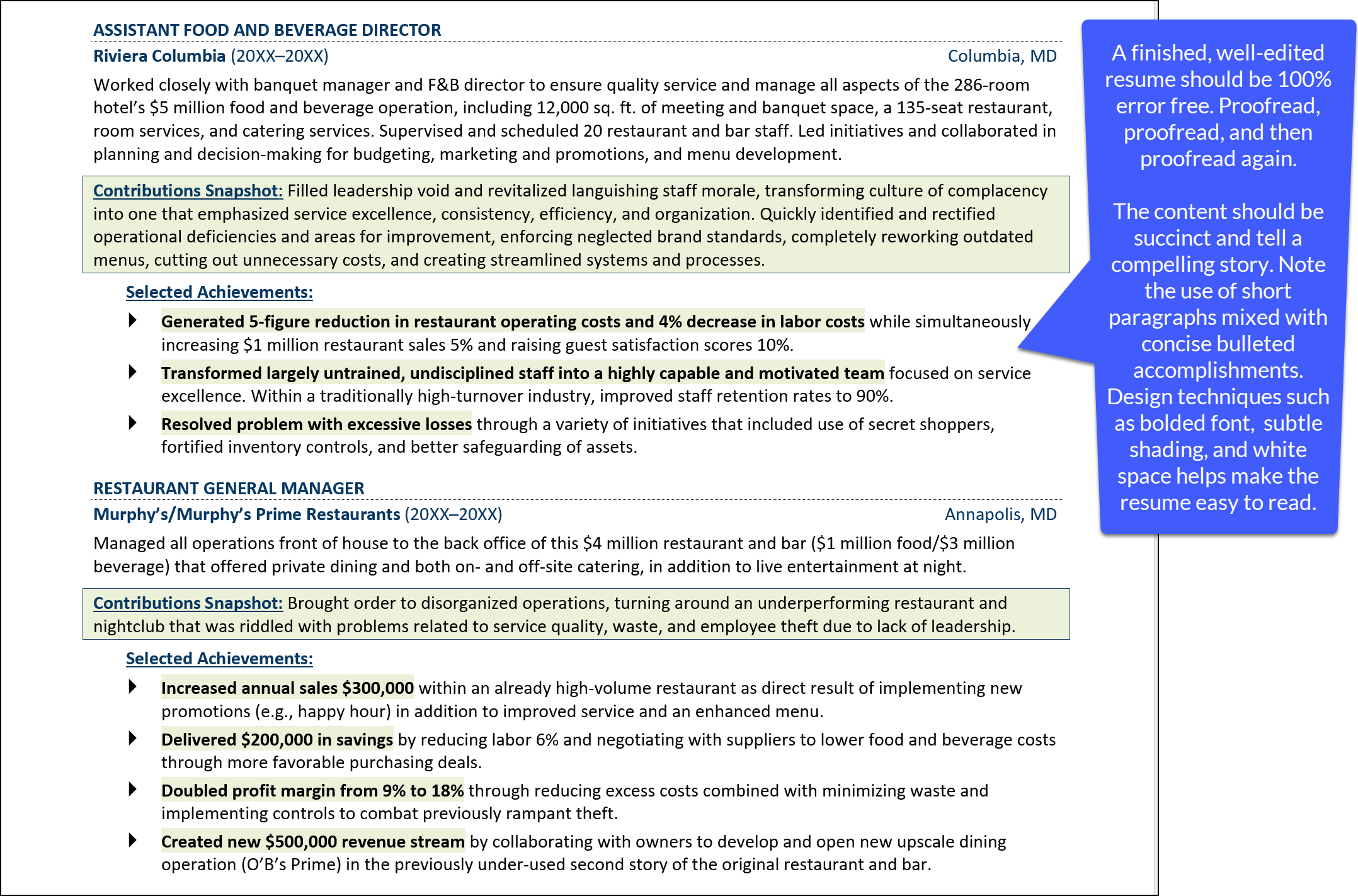
Step 7. Rearrange and restructure
In this step you will finalize the structure of your resume.
To ensure your resume stands out, put the most impactful material as close to the beginning as possible. ATS may “weight” keywords at the front of your resume higher. With human readers, this may be the only part they read.
Rearrange statements within job descriptions and re-order bulleted achievements. You might even rearrange major resume sections if you have a strategic reason.
If your education and training provide better qualifications than your employment, you might want to list your resume education section before your work history. For example, if you are changing careers, your recent training may be more relevant than your past jobs.
While chronological and functional formats are how most job hunters make a resume, there is a lot of room for creativity with these, and how you order your resume builder content makes a difference.
Every choice you make when you make a resume should be made for a well-thought-out reason. The way you arrange your content and present it can make all the difference in whether your resume is read or not.
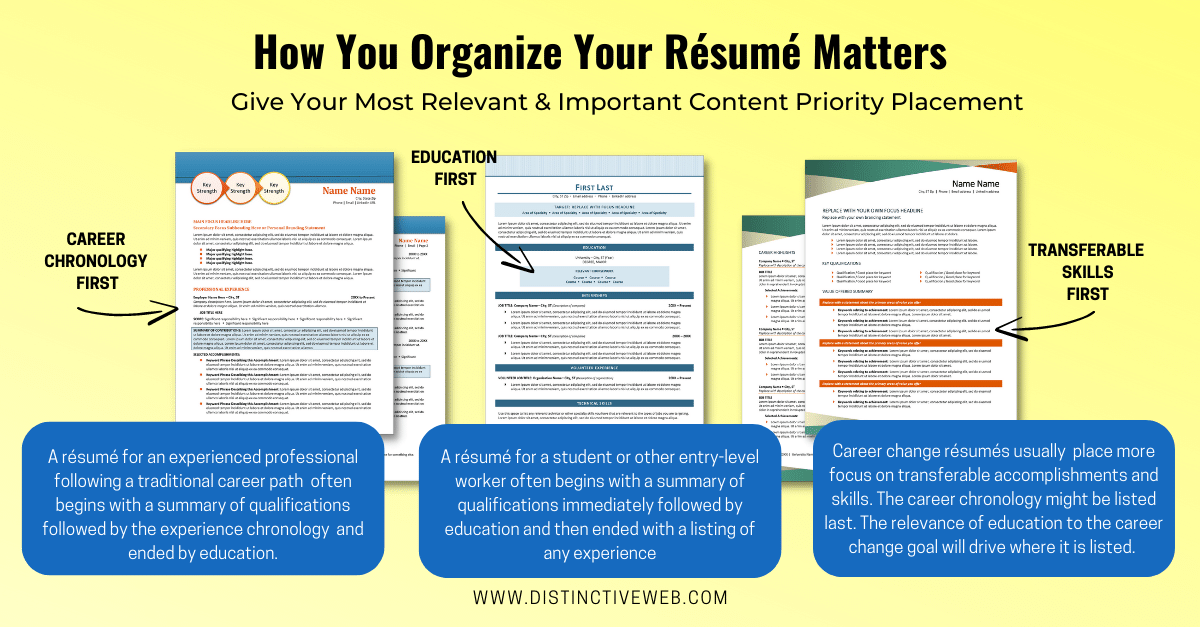
Step 8. Write your resume summary
Your summary is arguably the most important section, setting the tone and focus for the entire resume. Use it to highlight your best and most applicable qualifications and to showcase how you stand out from the competition.
While it might seem that you would write this part of your resume first, many experts advise that you write this section last.
Once the body of your resume is written, you can write your summary to do precisely what the name implies: use it to summarize the key points of the resume.
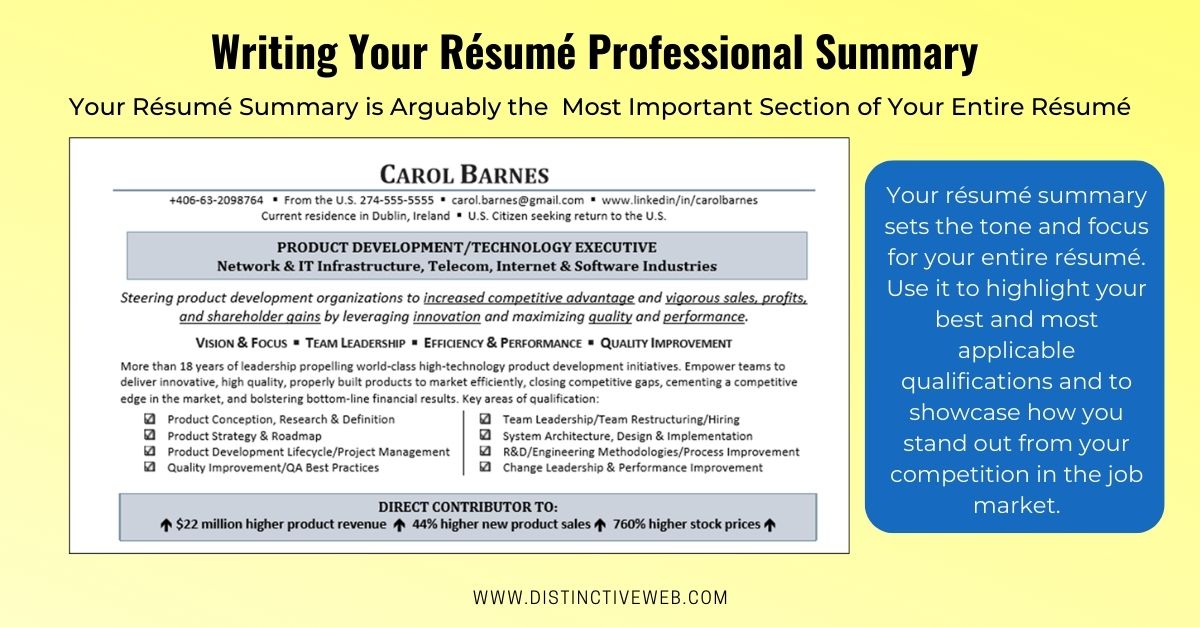
This example professional summary is a good illustration of a well-focused and relevant summary. While it is very skills based and includes many keywords, it also strongly emphasizes significant accomplishments and results that this candidate has delivered. Summarizing past achievements in this way provides proof of future potential and cannot help but grab the hiring manager’s attention.
Step 9. Make it pretty
Finally, a good resume is more than just content. Yes, the best resumes always begin with great, compelling content. But, if the design of your resume isn’t eye-appealing and easy to read, the recipient of your resume may never read that content.
After you’ve written and cleaned up the content, pull it all together in an appealing design.
Your resume design needs to be as unique as you are, and the format needs to showcase your most compelling qualities.
A resume template can be helpful, but only if you are confident that it is an ATS-friendly resume template that is easily customizable to fit the unique specifics of your career.
Charts, graphs, callouts, color, and other strategically used design elements can give your resume compelling eye appeal.
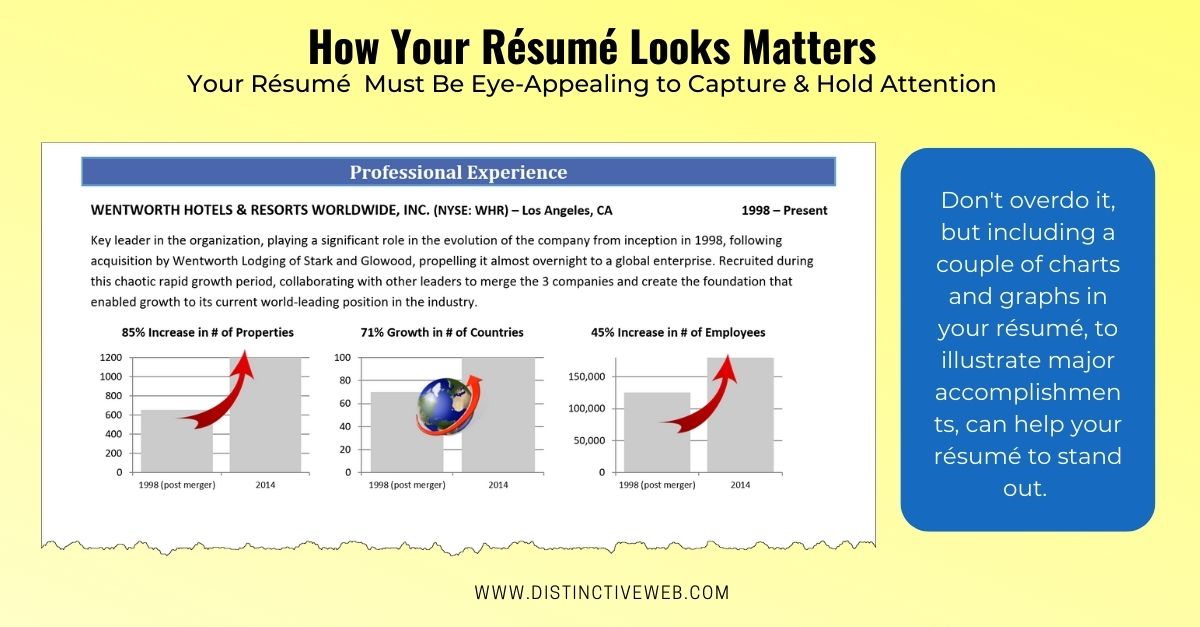
Your resume is your advertisement to hiring managers. It needs to sell them on your qualifications, and it needs to engage them. Quickly. Before they move on.
Final Resume Writing Tips
While learning how to write a resume is an essential skill, it isn’t a “one-and-done” situation. Resume styles, trends, and preferences change often. What was appropriate ten years ago, maybe even five years ago, may not be appropriate today.
This is one of the many reasons it is a smart idea to work with a trained, certified professional resume writer. Hiring a great resume writer is an investment that can pay you back many times over in your career.
We’ve worked with well over 10,000 job seekers in the past 25+ years at Distinctive Career Services and we’d be honored to work with you too. To learn more about getting help writing a resume or perfecting one you’ve written, we encourage you to book a free resume writing consultation to learn more about our services and how we can help you.
